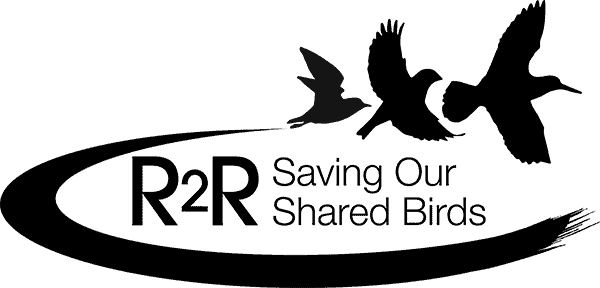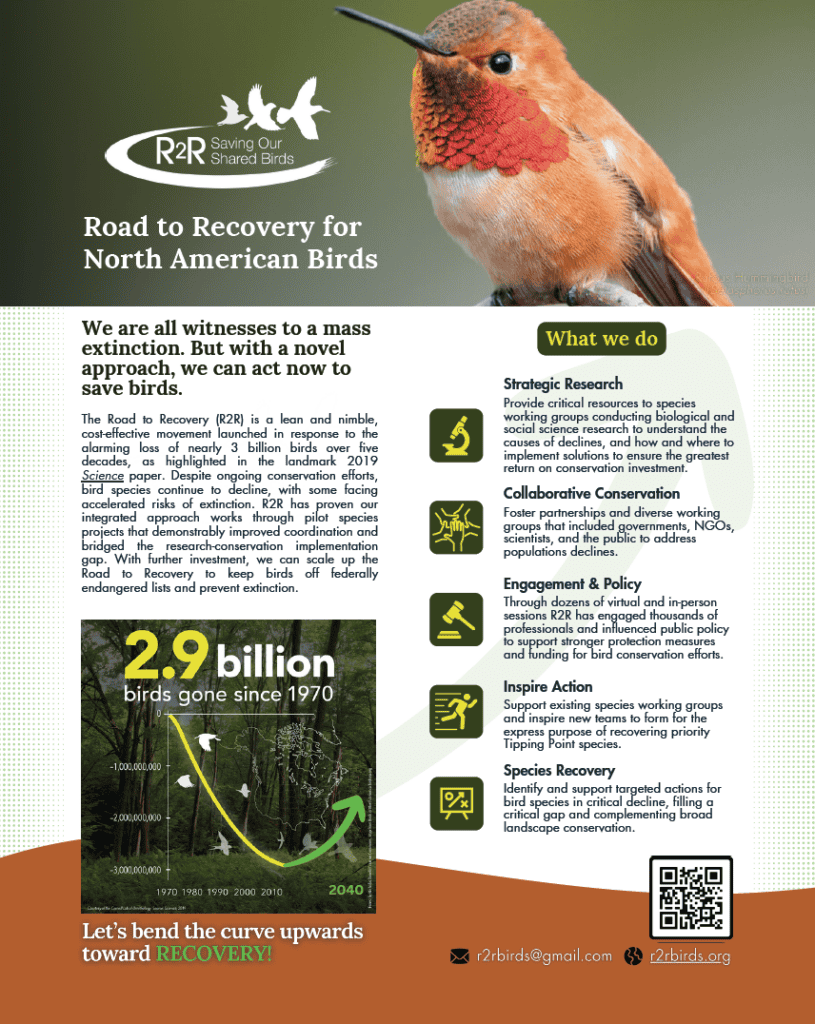About Us
A Response to the Decline of Birds in the United States and Canada
A 2019 landmark paper in Science reported major population losses—a total of nearly 3 billion birds from every biome across much of the United States and Canada. Although broad general threats to birds have been well documented (e.g., habitat loss, anthropogenic causes of mortality, invasive species), we still cannot pinpoint either the specific causes of declines for most bird species or the specific conservation actions that would effectively address those causes and reverse declines. Despite decades of sound ornithological science, landscape planning, habitat delivery, and monitoring, many bird species continue to decline precipitously. This trajectory of demise signals a process of eventual extinction.
In early 2020, we initiated a new path forward in the conservation of birds in the U.S. and Canada—an effort we are calling the Road to Recovery (R2R). The Science publication and the outreach efforts accompanying it succeeded in elevating awareness and attention, making “bring back 3 billion birds” a clarion call across the bird conservation community. Yet narrowing the gap between conservation gains and hemispheric environmental degradation and habitat loss will require a deliberate reimagining of the scope and strategies of bird conservation. Today, more species than ever are sliding toward threatened and endangered status. Not only does that mean more species are closer to extinction, it also means species, if listed, will be subject to regulatory action and cost taxpayers hundreds of millions of dollars. The time to act on this next set of what we are calling the Tipping Point Species is now. We need to be targeted, strategic, and swift if we are to recover these species and avoid listing status. In addition, just as the full annual cycle of avian species collectively connects multiple nations and cultures, our solutions to reverse declines must also more fully engage a broad spectrum of collaborators, including ecological and social scientists, land managers, private industry, and policy makers throughout the hemisphere.
Road to Recovery Partnerships
Collaborations with diverse conservation initiatives like Partners in Flight (PIF) and the North American Bird Conservation Initiative (NABCI)are critical to our success. R2R will work closely with established PIF working groups to assess species vulnerability and urgency, understand science gaps, increase social science capacity, and advance the efforts of species working groups. Likewise, R2R will collaborate with NABCI’s sub-committees to strategically meet conservation targets across the full annual cycle, advance human dimensions, and address environmental justice issues as they relate to bird conservation. Such collaborative efforts will provide a unified approach to recovering Tipping Point Species.
Guiding Principles
Our reimagining of bird conservation is empowered by four key guiding principles that will represent a significant change of course in the way bird conservation is practiced. First is a focus on demonstrated population recovery, which is different from a focus solely on habitat management or addressing broad threats; second, R2R strives toward incorporating social science and its insights into all phases of bird conservation; third, R2R is about practicing actionable science and implementation intentionally in tandem in such a way that the concept of an implementation gap is eliminated; and fourth, R2R will strive to achieve conservation in a manner promoting inclusivity and social and environmental justice with every action and at every step along the path to sustained recovery.
Diversity, Equity, Inclusion, and Justice
Road to Recovery is a conservation science initiative with the spirit of co-production at its core. We value scientific knowledge that advances the recovery of Tipping Point Species and recognize that this knowledge takes many forms and comes from a diverse array of contributors. Many of these contributors have been historically excluded from the research community based on race, ethnicity, sexual orientation, gender identity, education level, age, or socioeconomic position. We aim to support both a wide-reaching initiative and individual species recovery teams that are inclusive in their composition and hold equity, justice, and diversity as central to their goals and actions. We believe in a path forward where diverse human communities are valued partners working together to advance along the road to recovery for bird species.
We have identified 112 U.S./Canadian species most urgently in need of recovery. These species have lost half or more of their breeding populations since 1970 and continued or accelerated declines over the most recent three generations.
Cerulean Warbler – photo by Ray Hennessey
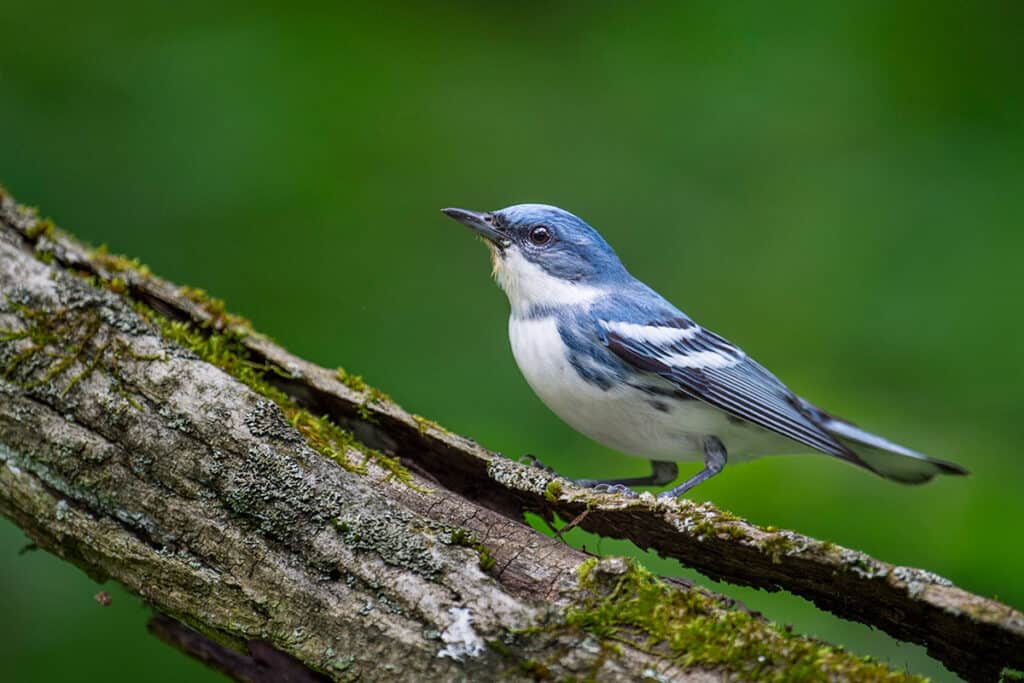
A Strategy for Reversing Avian Declines
A critical first step in R2R’s response to the staggering declines of bird populations in the U.S. and Canada was to develop a prioritization process for identifying the bird species most urgently in need of conservation action. To develop this list of species, we relied first on species-level data already available in the Avian Conservation Assessment Database (ACAD)—a database created and maintained by Partners in Flight (PIF) and housed at Bird Conservancy of the Rockies. Our assessment identified 112 Tipping Point Species that that require immediate, focused scientific action to pinpoint causes of declines and develop strategies for recovery. These species all show high vulnerability to extinction (assessed by scoring a series of independent factors—population size, breeding and non-breeding distribution, and threats), and worrisome population declines.
Tipping Point Species require research on a species-by species basis to identify what specific limiting factors are driving population declines across the full annual cycle—an essential step in developing targeted and effective implementation strategies to recover populations. It is also essential that our research efforts engage social scientists, users of the science (e.g., land managers, private landowners), and affected local communities initially and throughout the process—effectively eliminating the gap between research and conservation action and thereby accelerating sustainable recovery.
Directions of engagement over the next 12 months:
1. Develop a process for assessing progress toward recovery of Tipping Point Species.
- Determine which Tipping Point Species and other severely declining species have formed working groups/recovery teams. Assess meeting frequency, team composition, approach toward species recovery, incorporation of social science and co-production elements, and stage of progress toward recovery.
- For species without recovery teams, identify a process for building teams capable of co-production of actionable science and recovery.
- Seek to secure paid recovery team leaders for each species, perhaps organized by habitat type, to ensure steady progress toward recovery.
- Develop qualitative and quantitative metrics for advancing species along the road to recovery (outlined elsewhere), including an evaluation process with measurable medium- and long-term objectives.
2. Promote targeted and actionable science to recover bird populations.
- Identify and strategically fill critical knowledge gaps (e.g., migratory connectivity, limiting factors, broad scale threats) to advance species through the recovery process, including research on limiting factors and causes of declines, starting with Tipping Point Species but eventually including other declining species.
- Co-produce actionable research that also engages the users of the science (e.g., land managers, private landowners) throughout the process—effectively eliminating the concept of an implementation gap.
- Help to identify appropriate species-specific scales of action geographically and throughout the avian annual cycle.
- Provide social science assistance to species recovery teams/working groups.
3. Increase efficiency and effectiveness of implementation.
- Create new funding streams and seek to advance more effective use of existing conservation resources aimed at recovering populations of steeply declining bird species.
- Ensure that the best available natural and social science research is incorporated into conservation and management plans and conveyed across programs to recover species and lost abundance.
- Intentionally monitor effectiveness of conservation actions using adaptive feedback and considering both social and ecological outcomes.
The Recovery Process for Tipping Point Species
Road to Recovery proposes a process that needs to be applied on a species-by-species basis because even species that share the same habitat differ ecologically and are under different threats throughout their annual cycles. Even within a single species, sub-populations linked across the full annual cycle may be limited by different demographic rates or during different times of year.
The Road to Recovery Process has developed to incorporate biological and social science in parallel. This process may not be linear, and we recognize the importance of changing adaptively as we accumulate experience. The process consists of four phases that incorporate biological science, social science, co-production, and communications.
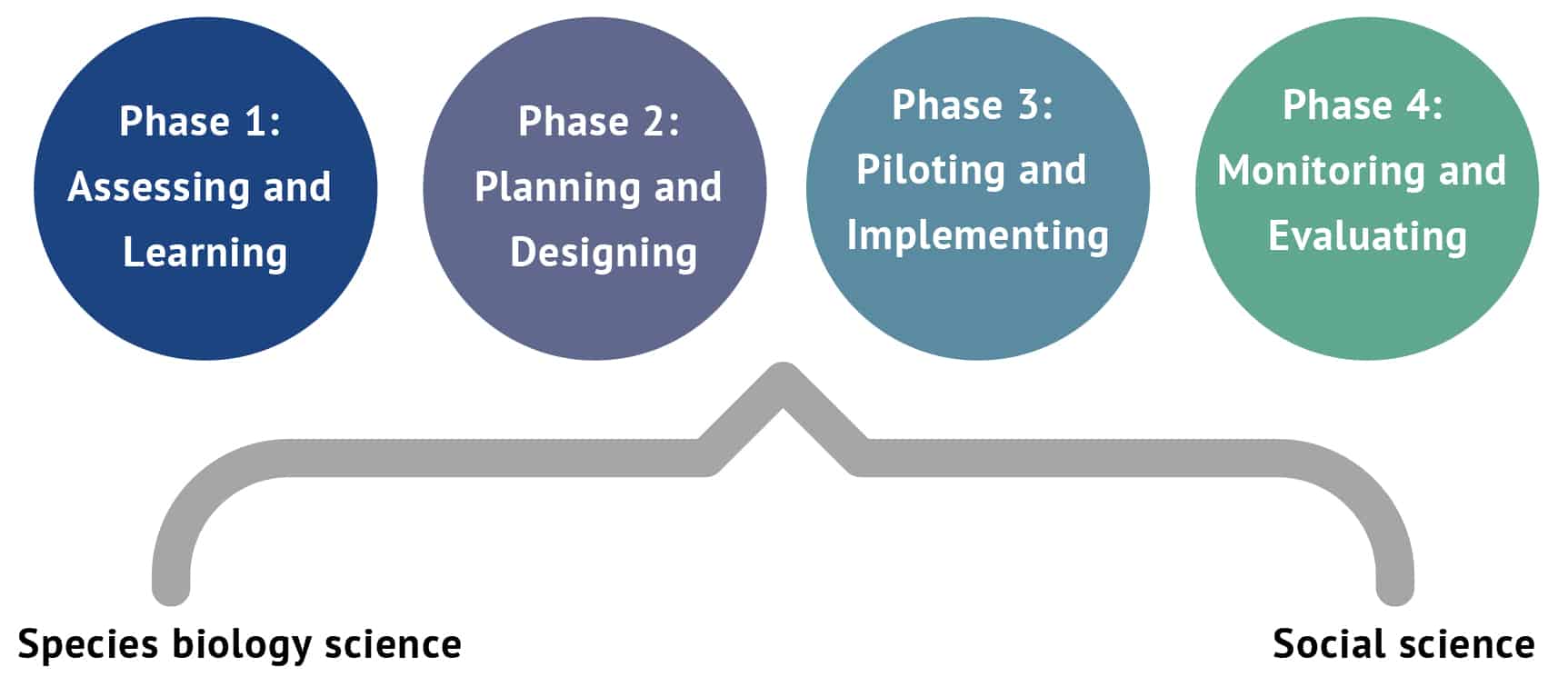
R2R’s Guidance Document describes the evolution of the Road to Recovery process, lists the steps present in each phase, and provides examples gathered from existing bird conservation efforts. We recognize that the design of the R2R process is not yet complete. There are challenges that will not be fully understood until a species is moved along the road toward recovery and information is gathered on how the process met these challenges.
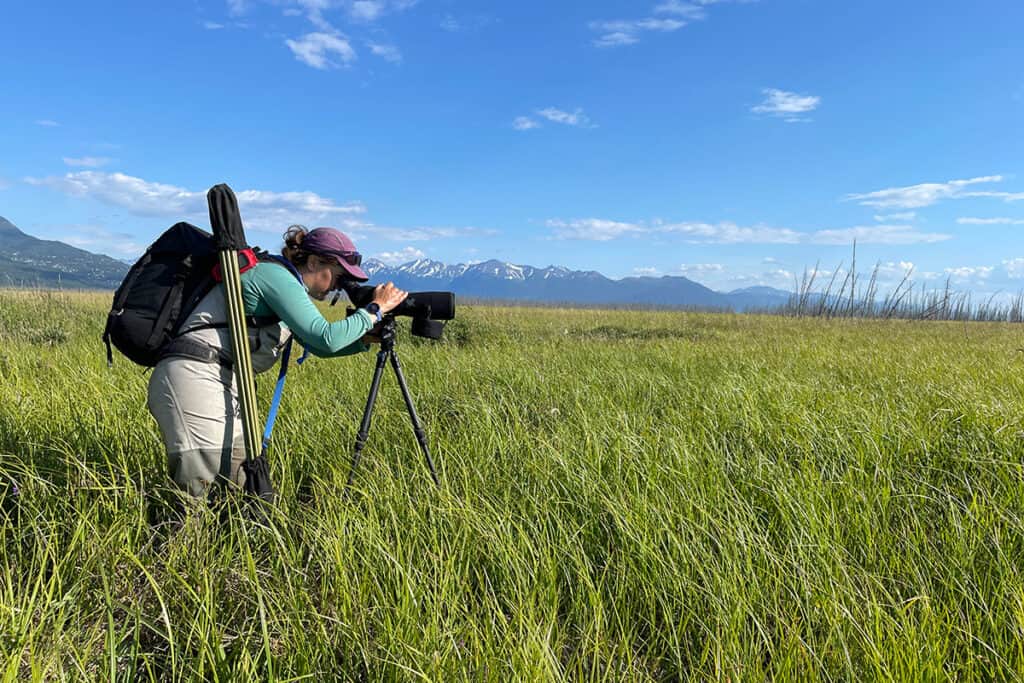
Photo by Arin Underwood
Our Staff & Committee Members
Learn more about the people that make Road to Recovery possible. With the help of experienced professionals from federal and state agencies, non-governmental organizations, and universities, R2R has developed a functioning process that will lead to the restoration of bird populations throughout the U.S. and Canada and across annual cycles.
